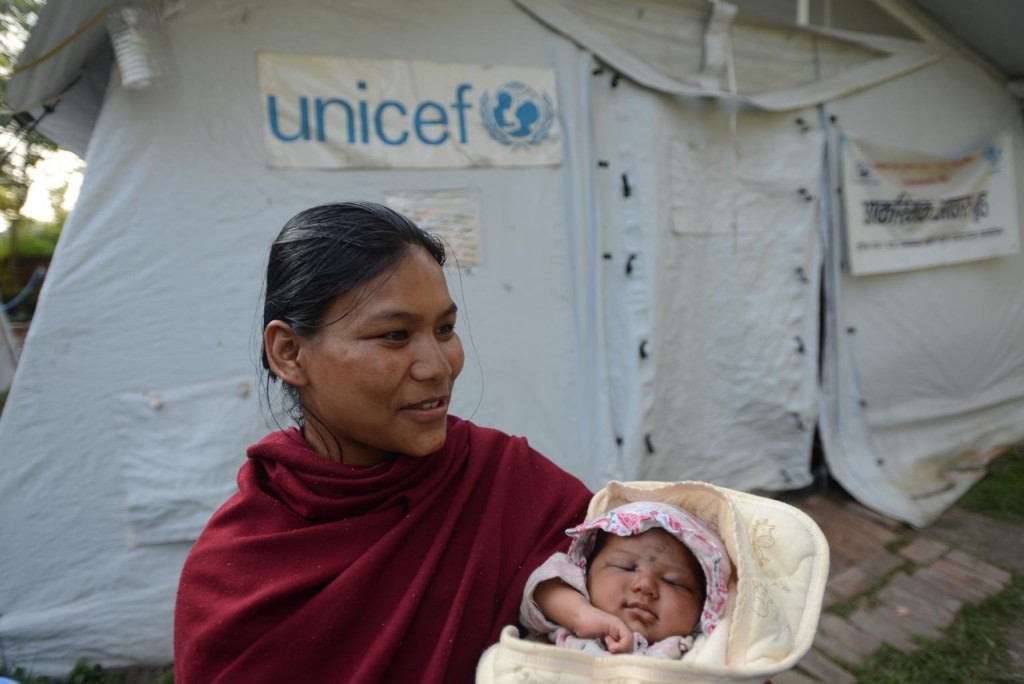A year on Nepal earthquakes: Education continues in affected districts but children still need safe and stable learning environment
2016-04-24
© UNICEF/UNI185885/Karki - After five week following the earthquakes of 25 April and 12 May, teachers, members of school management committee, students and parents worked together to set up the makeshift school. The earthquake in 2015 destroyed over 35,000 classrooms, jeopardizing the education of almost 1 million children in Nepal. Over 179,300 children benefited from the 1,793 temporary learning centres that established with UNICEF’s support.
KATHMANDU/ HONG KONG, 24 April 2016 – A year after devastating earthquakes in Nepal, 1.6 million school children are starting the new academic year in affected areas. Yet many of them continue to study in temporary classrooms. While recovery and reconstruction efforts are moving ahead, much remains to be done to ensure a rapid return to normalcy and predictability for these children.
“The devastating earthquakes last year destroyed or severely damaged over 35,000 classrooms. After that, tremendous amount of efforts were made to ing children back to school as soon as possible to minimize disruption of their education and exposure to risks of neglect, exploitation and violence," said Tomoo Hozumi, UNICEF Representative to Nepal. "Thanks to these efforts, schools in affected districts were reopened a month after the first earthquake in makeshift classrooms. Now we need to redouble our efforts to ensure children can study in safe transitional or permanent classrooms as early as possible.”
The 2015 quakes caused Nepal financial damages and losses equivalent to 36 per cent of its GDP. A year, there are still many needs to be met for children and families in the affected districts – be it a permanent roof over their heads, a safe school building or moving on with their livelihoods. Further prolongation of uncertainty can affect not only the education of children but also their health, nutrition, protection and overall development.

© UNICEF/UNI200548/MathemaOn 8 October 2015, Rupa Shrestha holds her 22 days old daughter in UNICEF supported shelter home for pregnant and lactating mothers in Bhaktapur Kathmandu. She came to the UNICEF-supported shelter home when she was 8 months pregnant and planning to stay in the shelter homehere for another couple of months as she has no place to go with such a small baby. Over 11,000 pregnant and postnatal women like Rupa had continuous and equitable access to primary health care services through 22 UNICEF-supported shelter homes.
Of the 188,900 people who had been temporarily displaced after the earthquake, over 85 per cent left displacement camps, while 26,272 are still living in camps. The construction of permanent buildings for the residents of over 700,000 destroyed houses started recently and needs to be accelerated in the months to come. In the meantime, the children and their families continue to live in makeshift shelters next to their destroyed homes.
Children living in such temporary shelters and still unstable environments are also vulnerable to various risks, including trafficking.
Between 25 April 2015 and 12 Feuary 2016, a total of 850 girls and boys were intercepted by police from possible trafficking and other protection-related risks. At an average of 89 children per month, this number was higher than the 69 cases per month between July 2014 to July 2015.
“The increased number can be attributed to the heightened risk to children in the wake of the earthquake, but can also be a testament to increased vigilance within Nepal,” said Hozumi.
Following the earthquakes, UNICEF also worked with the Government and partners and helped identify and register 39,337 unaccompanied, separated and vulnerable children. Of them, 13,317 were provided with emergency support that they required.
In addition, UNICEF has also helped:
- support establishment of 1,793 of the total 3,576 temporary learning centres built so far.
- provide education supplies to 881,000 children and trained 8,125 teachers to give psychosocial support and life-saving information for children;
- vaccinate 537,081 children under five years of age in the earthquake-affected districts against Measles-Rubella and Polio;
- provide 11,333 pregnant and postpartum women in 11 most-affected districts with access to 22 transitional shelter homes where they can stay before and after delivery to receive necessary services and care;
- screen 373,546 children aged 6 to 59 months to assess their nutrition status;
- reach 1,314,920 people with emergency and longer-term water supply services;
- provide 890,589 people with hygiene kits and key information on good hygiene;
- distribute emergency cash transfer of US$ 30 per person targeted to approximately 435,000 most vulnerable groups of people in the 19 earthquake-affected districts; and
- reach 1 million people in most affected areas with critical and life-saving information through special radio programmes.
In the coming months, UNICEF will help:
- build 74 earthquake resistant and fully equipped prefaicated health facilities with birthing units in nine earthquake-affected districts;
- provide safe water by assessing, repairing and rehabilitating 3,000 water schemes;
- build 800 semi-permanent school structures with two classrooms each;
- include school safety issue as an integral part of the new education sector plan for the period of 2016 to 2020; and
- organise second round of the emergency cash transfer programme to reach an estimated 250,000 children under 5 years of age in the 11 most earthquake-affected districts.
“A lot of work has been done for humanitarian relief and recovery in the affected districts so that education continues and outeak of diseases and severe malnutrition is avoided. But the country still has a long and hard road towards full recovery,” said Hozumi. “Together with other UN agencies and development partners, UNICEF will continue to work closely with Government and civil society not only to help children in earthquake-affected areas but also to apply the lessons learnt from this disaster to the entire country to help Nepal become better prepared for future disasters.”









